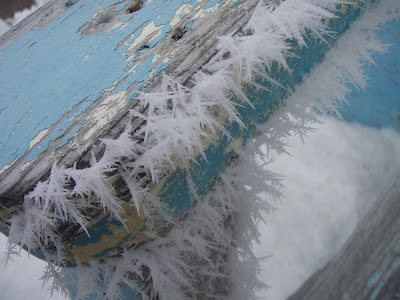The thing about researching life in the ice is that these creatures generally don't appreciate it when you take them out of their frigid environment. Some types of preserved samples are stable at room temperature, but when we're working with live samples, we have to keep them cold... which sometimes means we must brave chilly temperatures inside and out.
Of the three ice cores we take at each sampling station, we dilute two in filtered seawater and leave the remaining core sections undiluted. That means the first step when we get back to the lab from a field sampling session is to run the water we collected in a cubitainer (see the photo below) through 0.2 micron mesh to strain out the microorganisms living inside.
 |
| A 5 gallon (~19 liter) cubitainer |
The cores sections chill out in ziplocs in the refrigerator, slowly thawing. We don't want to melt them too quickly, because the algae and other critters living inside are psychrophilic (cold-loving) and could die at warm temperatures.
In the lab, we measure a number of different parameters, from salinity (how salty the ice core is) and concentrations of nutrients to the density of different types of particles, like organic carbon, carbohydrates, and sticky substances called EPS. Some of these things we can measure or analyze here in Barrow, while others, like chlorophyll and DNA, will have to wait until we're back at our home labs in Columbia and Arizona State Universities.
To make microscope slides, we filter different amounts of melted, fixed (preserved) ice core water onto special filters. Our filtration apparatus is somewhat temperamental, but we seem to be succeeding in sweet-talking it into leaking less often!
 |
| Researcher Amy Hansen filtering samples for slides |
All of these tasks can be accomplished in the nice, warm lab as long as we keep the samples in the fridge until we need them. For some experiments, though, we must venture into walk-in cold rooms.
Because of their salinity, our ice cold samples stay liquid below freezing. The cold room above is set at -1˚C (30.2˚F).
 |
| Andy Juhl and Susanne Neuer in the cold room. "It's coooold!" |
 |
| Indoor icicles |
We use this room to store our melted samples until they can be processed, and for settling column experiments.
One of the main drivers of our research here is to gain some insight into particle flux and carbon export in sea ice ecosystems. In a nutshell, particle flux refers to how particles--including cells, cell aggregates, and the fecal pellets of tiny algal grazers--sink to the ocean floor. How fast and how much of this marine snow falls to the sediment impacts not only the chemistry and biology of the sea bed, but also has implications for climate: carbon is a major component of these sinking particles, and carbon that ends up at the bottom of the ocean won't be respired, or converted to carbon dioxide, and released back into the atmosphere for decades, even centuries.
To investigate the science of particle flux and sinking speeds at our study site, we pour well-mixed, thawed ice core sections into graduated cylinders.
 |
| Craig Aumack, left, and Andy staying warm while setting up new settling columns. |
We take initial samples from the columns, then let them settle for several hours before sampling again, this time from the upper and bottom sections of the cylinder. Over that time, larger, heavier particles sink to the base of the column, while smaller, more buoyant particles stay near the surface.
Tomorrow we'll be heading out into the field again to collect more ice cores at our various sampling stations. The weather is slowly warming up here as the time between sunrise and sunset shrinks into nothing. We'll leave you with a parting shot of the ice-covered ocean near midnight:

























































